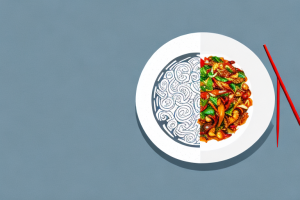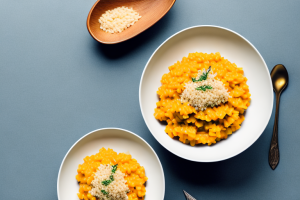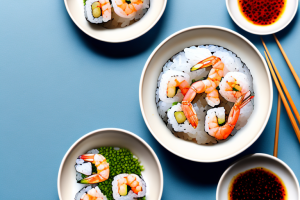How to prepare brown rice with asparagus and lemon zest
8 min read
A bowl of cooked brown rice
Do you find yourself always leaning towards white rice as a staple carbohydrate in your meals? It may be time to switch things up and try brown rice instead. Brown rice is a whole grain that has more fiber, vitamins, and minerals than its white counterpart. This article will show you not only how to prepare brown rice, but also how to make a delicious dish with asparagus and lemon zest that will make you wonder why you ever stuck with plain old white rice.
Why brown rice is a healthy choice for your diet
Let’s start with the basics. What makes brown rice a healthier option than white rice? Brown rice is a whole grain because the outer bran and germ layer remain intact during processing, providing more nutrients. It contains protein, fiber, B vitamins, and minerals like magnesium and selenium. White rice, on the other hand, has been stripped of these layers and is left with just the starchy endosperm.
In addition to its nutritional benefits, brown rice also has a lower glycemic index than white rice. This means that it causes a slower and steadier rise in blood sugar levels, making it a better option for those with diabetes or anyone looking to maintain stable blood sugar levels.
Furthermore, brown rice is a versatile ingredient that can be used in a variety of dishes, from stir-fries to salads to casseroles. It adds a nutty flavor and chewy texture to meals, making it a delicious and healthy addition to any diet.
The nutritional benefits of asparagus
Asparagus is a nutrient-dense vegetable that’s packed with vitamins and minerals. It’s also low in calories and high in fiber, making it a great addition to any meal. Asparagus contains high levels of folate, vitamins A, C, E, and K, as well as chromium, which helps to regulate blood sugar levels.
Additionally, asparagus is a natural diuretic, which means it can help to flush excess fluid and salt from the body. This can be especially beneficial for individuals with high blood pressure or other cardiovascular conditions. Asparagus also contains antioxidants, such as glutathione, which can help to protect the body against oxidative stress and reduce the risk of chronic diseases.
Furthermore, asparagus is a good source of prebiotic fiber, which can help to promote the growth of beneficial gut bacteria. This can improve digestion and support overall gut health. Asparagus also contains compounds called saponins, which have been shown to have anti-inflammatory and anti-cancer properties.
How lemon zest can add a burst of flavor to your rice dish
Lemon zest is simply the outer layer of lemon peel that has been grated or peeled off. It’s a great way to add a bright, citrusy flavor to your dishes without adding any extra liquid. Lemon zest contains essential oils that provide a strong aroma and flavor that pairs well with asparagus and brown rice.
In addition to its flavor benefits, lemon zest also contains several health benefits. It is a good source of vitamin C, which helps boost the immune system and aids in the absorption of iron. Lemon zest also contains antioxidants that can help protect against cell damage and reduce the risk of chronic diseases. So, next time you’re cooking rice, consider adding some lemon zest not only for its delicious taste but also for its health benefits.
The importance of washing and soaking brown rice before cooking
Before you start cooking your brown rice, it’s essential to wash and soak it to remove any excess starch and debris that can affect the texture and flavor. Rinse the brown rice in cool water until the water runs clear. Then, let the rice soak in water for at least 30 minutes or up to 4 hours. Soaking helps to soften the grains and reduce cooking time.
In addition to improving the texture and flavor of your brown rice, washing and soaking also has health benefits. Brown rice contains phytic acid, which can bind to minerals like zinc and iron, making them less available for your body to absorb. Soaking the rice can help to break down the phytic acid, making these minerals more accessible. Additionally, soaking can help to reduce levels of arsenic, a toxic substance that can be found in some rice varieties.
Step-by-step guide to cooking perfect brown rice with asparagus and lemon zest
Now that we’ve covered the basics let’s get cooking:
- Drain the soaked brown rice and add it to a pot with 2 cups of water.
- Bring the water to a boil, then reduce heat to low and let simmer for 40-45 minutes. You can also use a rice cooker or instant pot according to manufacturer instructions.
- While the rice is cooking, prepare the asparagus by washing and trimming the tough ends. Cut into 1-inch pieces.
- In a large skillet or wok, heat 1 tablespoon of olive oil over medium-high heat. Add the asparagus and cook for 3-4 minutes until tender-crisp.
- Add the lemon zest to the asparagus and stir to combine.
- Once the rice has finished cooking, fluff with a fork and add it to the skillet with the asparagus and lemon zest. Mix well.
- Season with salt and black pepper to taste. Serve hot.
Did you know that brown rice is a healthier alternative to white rice? It contains more fiber, vitamins, and minerals, making it a great addition to any meal.
If you’re looking to add more flavor to this dish, try adding some chopped garlic or ginger to the skillet with the asparagus. You can also top it off with some chopped nuts, such as almonds or cashews, for added crunch.
How to choose the best asparagus for your recipe
When selecting asparagus, look for firm stalks with tight tips and minimal signs of shriveling or browning. The asparagus should also have a vibrant green color, indicating it’s fresh and full of flavor. If possible, choose asparagus that’s all the same size for even cooking.
Another important factor to consider when choosing asparagus is the thickness of the stalks. Thicker stalks are ideal for grilling or roasting, as they hold up better to high heat and retain their texture. Thinner stalks are better suited for steaming or sautéing, as they cook more quickly and have a more delicate flavor. Keep this in mind when selecting asparagus for your recipe, and adjust your cooking method accordingly.
Tips for properly zesting lemons without any bitterness
Zesting lemons can be daunting, but it’s easy once you know the tricks. Here are some tips:
- Always use a microplane or fine grater for the best results.
- Only zest the outer layer of the lemon, being careful not to get any of the bitter white pith beneath.
- Use a firm, ripe lemon that hasn’t already started to dry out.
Another important tip is to wash the lemon thoroughly before zesting it. This will remove any dirt or residue that may affect the flavor of the zest. Additionally, it’s best to zest the lemon just before using it in a recipe, as the zest can dry out quickly and lose its flavor.
If you’re zesting a large quantity of lemons, it can be helpful to freeze the lemons for about 30 minutes beforehand. This will make them easier to handle and will also help the zest come off more easily. Once you’ve zested the lemons, you can store the zest in an airtight container in the refrigerator for up to a week, or freeze it for longer storage.
Adding other veggies to your rice dish for added nutrition and flavor
While asparagus and lemon zest go great with brown rice, you can also experiment with other vegetables like bell peppers, mushrooms, or zucchini for added nutrition and flavor. Just be sure to adjust the cooking times accordingly.
Bell peppers are a great addition to any rice dish, as they add a pop of color and a sweet, tangy flavor. You can use red, yellow, or green bell peppers, or a combination of all three. Simply chop them into small pieces and sauté them in a pan with some olive oil before adding them to your rice.
Mushrooms are another great option for adding flavor and nutrition to your rice dish. They have a meaty texture and a rich, earthy flavor that pairs well with rice. You can use any type of mushroom you like, such as button, shiitake, or portobello. Simply slice them thinly and sauté them in a pan with some garlic and butter before adding them to your rice.
Pairing this dish with protein for a complete meal
This dish can be a perfect side dish or a light lunch option but feel free to add some protein like grilled chicken, tofu, or shrimp to make it a complete meal.
Adding protein to this dish not only makes it a complete meal but also increases its nutritional value. Grilled chicken is a great option as it is low in fat and high in protein. Tofu is a great vegetarian option that is also high in protein and can be marinated to add more flavor to the dish. Shrimp is another great option that is low in calories and high in protein.
When adding protein to this dish, it is important to consider the cooking time and method. Grilled chicken and shrimp can be cooked separately and added to the dish, while tofu can be sautéed or baked with the vegetables. This will ensure that the protein is cooked to perfection and complements the flavors of the dish.
How to store leftovers for meal prep or enjoying later on
This dish stores well in the refrigerator for up to four days when stored in an airtight container. You can reheat it in the microwave or on the stovetop with a splash of water or broth to prevent drying out.
It’s important to note that not all leftovers are safe to eat after four days. Some foods, such as cooked meats and dairy products, can spoil quickly and should be consumed within two to three days. To ensure the safety of your leftovers, always check the expiration dates of the ingredients used in your dish and follow proper storage guidelines.
Brown rice and asparagus: a winning combination for weight loss goals
If you’re trying to lose weight, brown rice and asparagus can be an excellent addition to your diet. Brown rice is a complex carbohydrate that provides sustained energy, while asparagus is low in calories and high in fiber. Plus, the flavors in this dish are so good, you won’t even feel like you’re on a diet!
Gluten-free option: using brown rice instead of wheat-based grains
Brown rice is naturally gluten-free, making it an excellent option for those with Celiac disease or gluten intolerance. As a more nutritious alternative to wheat-based grains, it’s also a delicious choice for anyone looking to diversify their diet.
Serving suggestions: how to plate and garnish your dish like a pro!
To make your dish look as good as it tastes, here are some tips for plating and garnishing:
- Use a wide and shallow bowl or plate to showcase the rice and asparagus.
- Arrange the asparagus on top of the rice for a beautiful pop of green.
- Garnish with lemon wedges, fresh parsley, or crushed red pepper flakes for added flavor and visual appeal.
There you have it, everything you need to know to make a delicious and healthy brown rice dish with asparagus and lemon zest. These flavors are sure to become a new favorite in your weekly rotation!


